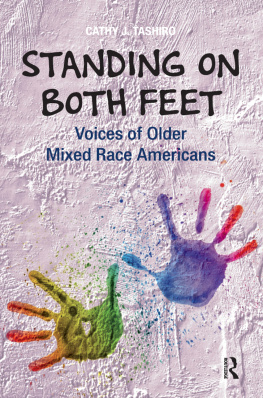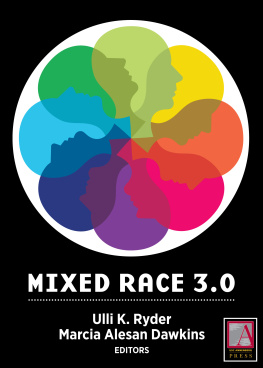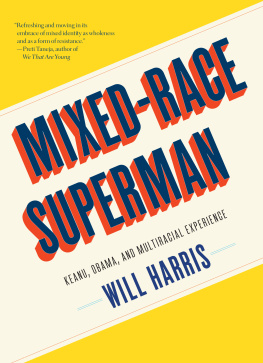First published 2012 by Paradigm Publishers
Published 2016 by Routledge
2 Park Square, Milton Park, Abingdon, Oxon OX14 4RN
711 Third Avenue, New York, NY 10017, USA
Routledge is an imprint of the Taylor & Francis Group, an informa business
Copyright 2012 Cathy J. Tashiro
All rights reserved. No part of this book may be reprinted or reproduced or utilised in any form or by any electronic, mechanical, or other means, now known or hereafter invented, including photocopying and recording, or in any information storage or retrieval system, without permission in writing from the publishers.
Notice:
Product or corporate names may be trademarks or registered trademarks, and are used only for identification and explanation without intent to infringe.
Library of Congress Cataloging-in-Publication Data
Tashiro, Cathy J.
Standing on both feet : voices of older mixed race Americans / by Cathy Tashiro.
p. cm.
Includes bibliographical references and index.
ISBN 978-1-59451-983-3 (pbk : alk. paper)
1. Racially mixed peopleUnited StatesSocial conditions. 2. Racially mixed peopleRace identityUnited States. 3. Racially mixed peopleUnited StatesAttitudes. 4. Older peopleUnited StatesSocial conditions. 5. Older peopleUnited StatesAttitudes. 6. MiscegenationSocial aspectsUnited States 7. RaceSocial aspectsUnited States.
I. Title.
E184.A1T37 2012
305.800973dc23
2011024630
Designed and Typeset in Adobe Garamond by Straight Creek Bookmakers.
ISBN 13 : 978-1-59451-982-6 (hbk)
ISBN 13 : 978-1-59451-983-3 (pbk)
Like the people in this book, I am an older mixed race American. I was born in Cincinnati in 1946 to a Nisei (second generation, U.S. born) Japanese American father who became a doctor; my mother is from a white working-class family in Kentucky. My parents got together right at the end of World War II, when there was a lot of anti-Japanese sentiment, and my white grandfather initially disowned my mother for marrying my father. Eventually, when the children started coming, my mother was accepted back into her family.
My early years were spent in some very remote places in upstate New York and Michigan. My father had a series of jobs working in tuberculosis sanitariums, and we lived on the grounds of these institutions. It only occurred to me much later that these might have been the only jobs available to him as a Japanese American doctor in the immediate postWorld War II era. We were very isolated, and my happiest childhood memories are of the summers we spent at my Japanese grandparents summer home, because my aunt and uncle and their mixed race children were also there. It felt like we were our own tribe, and this was the only time in my childhood when I remember having a sense of belonging. It never occurred to me that my sense of alienation was related to race, but I had a vague sense of how skin color and ancestry set us apart.
When asked, I usually told people I was half Japanese, but when we visited my grandparents on my fathers side in the summer, I knew I wasnt Japanese. They ate weird food and spoke Japanese, which I didnt. My father tried his very best to be a super American. Assimilation was the goal for Japanese Americans his age in this postwar period. He taught us no Japanese, and he expected my mother to cook American food. I remember wanting to be more Japanese, or perhaps thinking I should be. One brief endeavor at becoming Japanese was my attempt to kneel for long periods on the rubber cushions taken from the couch at my Japanese grandparents house. Im not sure where I got this idea, maybe from the movie Sayonara. I knew Grandma thought this was ridiculous. She certainly didnt spend her time kneeling in a kimono. She usually wore an old housedress while taking on projects like darning socks or painting the houseand memorably berating my grandfather in Japanese. Kneeling was painful and quickly forgone. Somehow I learned a few important basic words, like mizu (water) and gohan (rice). I think that in a very basic way, I was searching for who I was or where I fit. My images of what being Japanese might be were of the same distorted caricatures shared by the general population. The contradictions abounded; I remember the old World War II paperbacks at my Japanese grandparents home depicting ugly, buck-toothed Japanese war pilots as the enemy. When we got a television in the early 1950s, one of my fathers favorite shows was Victory at Sea, a documentary of World War II naval battles, primarily carried out against the Japanese.
I spent my formative adolescent years in the late 1950s and early 1960s in an upstate New York town so small it could barely be called a town; no other people of color or mixed race lived there. Although white, the town was ethnically diverse. There was Guinea Alley (this was before the advent of politically correct speech), where many of the Italians lived, and being Catholic seemed to forge a bond that overcame ethnic boundaries for Italians and Poles. I didnt think of my town as white. To my adolescent eyes, people just were who they were. But who I was and how I fit in were mysteries. Race at that time and place meant Negro. I wasnt Negro, but I knew I was different.
I will never forget the first time I saw the public face of someone who looked like me, when I went to see the film South Pacific, which was released in 1958 and played at my small-town movie theater. The part of Liat was played by France Nguyen, who was born to a Vietnamese mother and French father in France. She was supposed to be Polynesian. The ethnicity of her characters mother, Bloody Mary, the Chinese Hawaiian souvenir dealer, didnt match that of the woman playing her either, Juanita Hall, the great actress and singer of obviously mixed African American ancestry. Like the public, Hollywood has long had difficulty placing people of mixed race, which is interesting given that South Pacific is about prejudice against intermarriage and having mixed race children. But that night, I wasnt thinking about any of that. I was astonished that someone who was clearly (to me) neither wholly Oriental nor wholly Caucasian was on the screen, someone who looked like me. I remember going to the corner store after the movie, buying something, and lifting my face to the Italian owner with a feeling of pride, a sense that I was somehow placed and recognizable for the first time in my life. I was so excited, I couldnt sleep that night.
Flash forward to 1990. The words People of Mixed Blood leapt off the page at me. I was leafing through a booklet of classes to distract myself while at work in the student health center at the University of California, Berkeley. Illustrated by a picture of a professor and students of racially ambiguous appearance, the title advertised a class taught by Terry Wilson of the Native American Studies Department, the first class ever offered on the topic of mixed race at an academic institution. I was astounded and thrilled that someone had named what I struggled to understand, even in middle age, and that it was considered legitimate enough to merit a class at Berkeley. The phrases mixed blood and, later, mixed race brought clarity to my own previously inchoate experience. Naming mixed race made it real and worthy of examination. That moment marked a major change in consciousness for me.









